

 |
 |
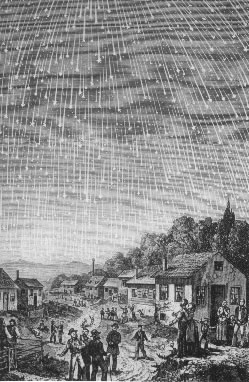 |
Planet Earth, comets, meteors and the story of life and death are all intimately linked together throughout the geologic pages of the violent story book of our solar system. Our solar system has always been a violent place since its formation 4.6 billion years ago and contrary to popular belief this process is still ongoing today. One way to get a real time glimpse of this evolving story is to step outside under a dark starry night and watch a meteor shower. When we do this we can actually witness first hand the cosmic debris which our planet encounters during its lazy journey around the sun. This weekend we had two reasons to watch the skies. On friday Nov 17/18th the Earth would plough its way through a stream of meteoroids from comet 55P/Tempel-Tuttle, a large ancient comet which falls into the inner part of the solar system every 33 years producing the annual Leonid meteor shower. This is without doubt the most famous meteor shower in recorded history, once every 33 years when Tempel-Tuttle reaches perihelion it replenishes the Leonid meteoroid stream with a young dense swarm of material which can produce a meteor storm. There have been several spectacular storm periods recorded and one of the most famous was the storm of 1833 when an estimated 200,000 meteors per hour were seen by startled witnesses who described the stars 'falling like rain'. |
Below: The orbit of periodic comet Temple-Tuttle.
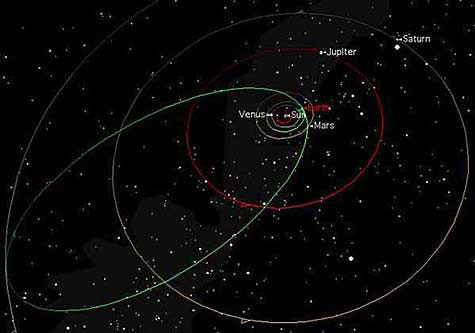 |
In the 1990's storm levels were again observed however the future was not looking good for the Leonids. In 2006 the Leonid progenitor comet would not be anywhere near perihelion resulting in the 'normal' Leonid meteor shower when a single observer can expect to see between 5 - 20 meteors per hour under excellent conditions. This normal peak would take place at 23.00 UT on Friday evening so we planned a watch for this date. However there was a surprise in store! Dr. David Asher from Armagh Observatory and colleague Robert Mc Naught predicted that the Earth would encounter a dense swarm of small Leonid particles which were ejected by the comet in 1932, when this happens observers would expect to see between 100 - 150 meteors per hour - a Leonid outburst!. The encounter was predicted to take place over western Europe at 04.45 UT on Sat/Sun night on November 18/19th. |
As the particles would be small in size the astronomical community were cautioned that any meteors observed could be quite faint and therefore dark clear skies would be required for the best view. This was something very special indeed as no more significant outbursts from this shower are expected until beyond 2030. This was an opportunity not to be missed plus keep in mind that this enhanced activity would take place combined with the normal background Leonid stream so we would be guaranteed to see something. Observing The LeonidsObserving meteors is an easy and enjoyable pursuit. No telescopes or binoculars are required as the naked eye is the perfect capturing device. RIGHT: LEONID DEBRIS CLOUD DIAGRAM BY JEREMIE VAUBAILLON |
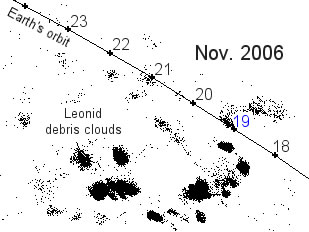 |
All that one needs to do is find a dark location, wrap up very warmly, get dark adapted and look up. There are several other meteor showers visible however the Leonids can be identified by their high velocity in comparison to other meteors. Moving at 72km/sec these are the fasted meteors in the sky which radiate from a small section of sky within Leo the celestial Lion which climbs above the NE horizon at approximately 23.00. Leo is easily identified by the bright star 'Regulus' and its curving chain of naked eye stars which form its 'Sickle' asterism which is also known as a backward question mark. Planet Saturn is also nearby as a gold coloured star which does not twinkle acting as a good guide for newbies. A word of warning regarding the outburst on the 19th - although the outburst is expected to occur at 04.45 UT it is advisable to watch several hours before hand incase this activity takes place earlier than predicted. Mother nature tends to be unpredictable so planning ahead and preparing for the unexpected will increase your chances of success. The following report documents two nights of Leonid meteor action in the skies above Maghera.
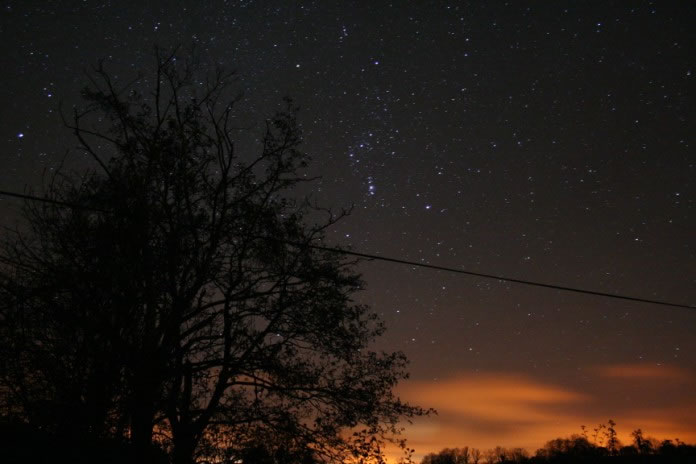 |
(Above) Orion the hunter hangs above tree tops under sparkling clear skies during the 2006 Leonid meteor shower from outside Maghera. The winter Milky Way can be seen running down through the image. The bright star to the upper left is Procyon in Canis Minor. Image Credit Conor McDonald.
Friday evening was a cold clear sunny day. We had our first snowfall of the season in the form of a white blanket on top of Slieve Gallion mountain which could be seen from my front garden. Conor Mc Donald and myself had met up briefly to finalize or plans for tonight's meteor watch. We decided to meet up around 23.00 UT and walk to a suitable location to watch the traditional Leonid peak.
We met as planed, packed food supplies and a flask of tea into our kit bags along with our cameras, tripods and a note book to record our observations. We walked 0.25 miles out along a country road at the perimeter of Maghera and chose one of our usual observing locations which involved climbing several barbed wire fences and traversing two soaking fields until we arrived at our destination near a small forest. However just as we cleared the barbed wire fence we got a nice surprise. A mag - 5.0 Taurid fireball fell slowly into the south, visible for several seconds, this fireball had no tail but sported a brilliant silver diamond head which could be seen shining through the orange coloured dense murk which hung over Maghera. The fireball seemed to drop low over the town itself and no doubt others witnessed it also. The session got off to a great start!
The weather conditions were harsh. It was wet, freezing, with a bone chilling cold breeze however the sky was in good shape with a limiting naked eye mag of + 6.2. The cold breeze was making this a very tough session and we found ourselves shivering within a very short period of time despite wearing several layers of clothing. Even our hot tea turned cold within one minute due to the horrendous wind chill. It was one of those harsh nights that made you want to keep your hands in your pockets all night and it took every bit of willpower to set up our cameras and tripods which threatened to blow over in the wind. We persevered and did our photographic meteor patrol in several strategic positions which had been worked out in advance during recent observing sessions. We seen a number of meteors from various meteor showers which are documented in the table below...
Hourly Watch (UT) |
Leonids |
Taurids |
Non Shower Meteors |
Total |
Fireballs |
23.30 - 00.30 |
2 |
5 |
4 |
11 |
1 |
00.30 - 01.30 |
5 |
4 |
2 |
11 |
0 |
Total Meteors Observed = 22
Total Leonids Observed = 7
Total Taurids Observed = 9
Total Non Shower Meteors Observed = 6
Total Fireballs Observed = 1
The Taurids proved to be very active and I am confident that 3 of the non shower members observed were in fact early Geminid meteors.
By 01.30 UT the sky was rendered overcast and as an excuse to warm up we decided to relocate several fields to the west where we ended up laying down on a concrete embankment with a nice stream cutting through the fields which was very peaceful. To keep our spirits high we listened to a few Christmas songs on my mp3 player (yes we are crazy) however by 04.00 heavy rain arrived followed soon after by icy sleet. We walked back to my house for shelter and savoured a proper warm cup of tea and discussed photographic techniques while periodically checking the sky conditions but things were not looking good. The sleet was here for the night and by 05.00 Conor and I ended the session. I continued my watch from inside my bedroom window and retired at 06.00. Judging from what we seen the traditional Leonid peak was very poor indeed with only 7 members observed which was rather surprising but we did not loose faith as tommorow night would bring with it a Leonid outburst!
Today had got off to an early start. After arriving in from last nights meteor watch I only managed to grab 30 min's of fitful sleep before I had to awaken early and travel to Ballymena to attend a live studio interview with BBC Radio Ulster before 09.00 during which I got a chance to talk about tonights meteor outburst. I enjoyed the interview very much and was delighted to inform the public of this special sky event. I also had a very fascinating conversation with Jim Kelso in the studio for 30 min's before going on air so Jim if you reading this - thanks for the exciting chat. It was midday before I arrived back home and any chances of sleep eluded me so I got up and began making preparations for tonights observing session.
I made and received a few phone calls and the night was organised. Four observers: John Mc Connell (FRAS), Conor McDonald and Jonathan Bingham would rendevous at my house later in the evening and we would take things from there. We had the observers now all we needed was the weather. A quick check on the forecast showed an evening of clouds and rain however it looked to clear up in the early hours of the morning so things looked very promising indeed. Meanwhile I connected to the internet and logged onto a radar tracking station in New Mexico, once the audio stream was downloaded I could 'listen' for meteors in real time as they burnt up over the skies above Mexico. The good thing about radar/radio is that meteors can be detected in overcast skies and during the day time. I could hear a ghostly ping through my speakers when a meteor event occured which was very exciting.
Jonathan arrived down after 19.00 and with him he brought a selection of fossils and rock sample deposits courtesy of his open university course based on Earth science and Astronomy. Some of the fossils in his collection were dated at over 300 million years old. We spent a fascinating hour studying these samples and reading the accompanying literature and spent the remainder of our time watching a recent episode of the BBC Sky & Night programme featuring a star party to set the mood. By 21.00 John McConnell arrived down followed at 23.00 by Conor Mc Donald which made the team complete.
We checked the sky periodically during the evening however all we could see were orange and grey clouds complimented by steady drizzle which did not affect us in the slightest as we had faith that the sky would clear. All of our team members have spent a great deal of time in various fields of Astronomy and after spending hundreds of hours spread over many years looking skyward one tends to develop a sixth sense when anticipating the likelihood of a clear sky. We were all confident we would get a good show tonight! We all gathered into my living room, had a warm mug of tea (a hot brew is more important than a telescope!) and made ourselves comfortable in front of the welcoming electric fire. In the background we played a DVD featuring several astronomical documentaries while we had a great conversation. It was a very nice cosy atmosphere which we all enyoyed very much. It was quite apparent that even my dogs, Benson and Drew enjoyed the company also. The relaxed conversation was suddenly interrupted at 00.30 when Conor announced that he could see clear breaks forming rapidly in the clouds - at once the lazy atmosphere was terminated and with it came the feeling of anticipation and excitement. It was time for action!
We grabbed our cameras, tripods, supplies and split up into two car loads and quickly took off to our pre determined location which Conor and I had choosen well in advance however when we arrived at our destination it became apparent that it was not suitable for our cars so we drove on deeper into the countryside. We had no idea where we where going however driven by instinct we continued on our journey like two steathly steal foxes hunting through the darkness. By now we had delved into the heart of the countryside several miles outside Maghera into unknown territory navigating along a narrow road which cut through the middle of nowhere. Even by glancing through the frost smeared windscreen we could see the stars shining very brightly so we pulled unto the grass verge skirting the side of the road and exited from the vehicles.
Within seconds of stepping outside the full glory of the sky was difficult to take in. The sky was very dark, transparency 8/10, the winter Milky Way could be seen extending from the northern horizon in Cygnus, arching overhead and descending into the southern horizon into Canis Major. Even before true dark adaption developed we could see the subtle elongated green form of the elusive Gegenschein below the Pleiades star cluster. This was the perfect location with a great panoramic horizon puncuated by the dark outline of pine trees. The sky was dark, the environment silent and the only light we could see was a faint orange glow from the hall of a lonely house tucked into the trees which did not interfere at all with the sky. The limiting naked eye magnitude was + 6.5 and objects such as M41, M31, M33, Double cluster, Beehive cluster were easy naked eye sights. With binoculars we had a look at the glorious Orion Nebula (M42), M41, M44, M31, M33, the three clusters in Auriga and M45.
Orion was a stunning sight hanging above tree tops in the SE and to it's lower left was the complete constellation of Canis Major and Puppis topped by brilliant Sirius - the brightest star in the sky. In the NE stood the sickle of Leo where the Leonid radiant could be found and the steady golden light of planet Saturn close by. This was a proper astronomers sky and the excited comments from the group were a testiment to the superb sky before us. What about the weather? - it was completely clear, calm and freezing with a temperature of - 2*C and it wasn't long before a rock hard frost had developed over the car roof and roadside which made it very slippery to stand on. Everything had come together perfectly now all we need was the meteors.
We settled into our location quickly and at 01.00 began our meteor watch. This was a combination of a visual and photographic watch. We had four pairs of eyes on the sky covering all compass points and four cameras set up taking exposures of various sky sectors in the hope of catching a piece of Temple-Tuttle. I decided to turn my camera east where Sirius, Orion and Procyon would neatly fit into my cameras field of view. I began taking images one after the other at ISO800/15 second exposure at F/3.2, Conor began his patrol and John set up his favourite film SLR camera and began his own. Jonathan was kind enough to take charge of the cooking and within no time we had devoured a warm tasty burger washed down with a mug of tea and a dessert consisting of a few festive mince pies.
After which we continued our patrol and we began seeing meteors. I had brought along a note pad, pen and red torch to record the activity with the intention of obtaining hourly rates of the various meteor showers visible. Some meteor watches involve a long slow wait before anything exciting takes place and yet others can begin with heart pounding action - this was one of those watches!
At 01.27 UT the Leonids introduced themselves to us in spectacular fashion. Without warning an incredible Leonid fireball emerged out of the NE sky passing slowly through Leo, Cancer and burning up in Canis Minor. It was a brilliant shadow casting object with striking orange, green, blue and silver colours with a long multi coloured tail lasting for a duration of three seconds. A scream of excitement and other choice words ascended into the sky in reaction to this stunning object but wait a moment I thought to myself, that was very close to where my camera was pointing. I previewed my last image on the LCD screen and was delighted to see that I had caught and no more the western edge of the fireball just as it burnt up however further roars of excitement interrupted from behind me and as I looked towards my three companions I could see that they were pointing into the eastern sky.
The show was far from over as our amazing fireball had left in its wake a rare residue in the sky. Hanging among the stars was a large bright smoke train which came from the event. This was a spectacular sight, the train was green visually and we could actually see it changing shape in real time from an elongated feature, into the shape of a scorpion's tail (John's words) and finally into a shape resemabling the famous Veil Nebula. This smoke train was located in Canis Minor east of and very close to the naked eye star 'Procyon'. We watched in awe as the train very slowly drfited away from Procyon by high altitude winds causing this ghostly form to drift back toward the radiant where it had originally came from. After checking my watch I was amazed to note that this fireball smoke train was visible in the sky for 7 minutes!
I took a series of images of the train and so did Conor who was very quick to react. Turning his Canon 350D camera with 300mm telephoto lens which he had just got new the previous day he zoomed in and focused with the swiftness and expertise of master photographer and took a series of close up images of the train. Both of our image sets can be found below...
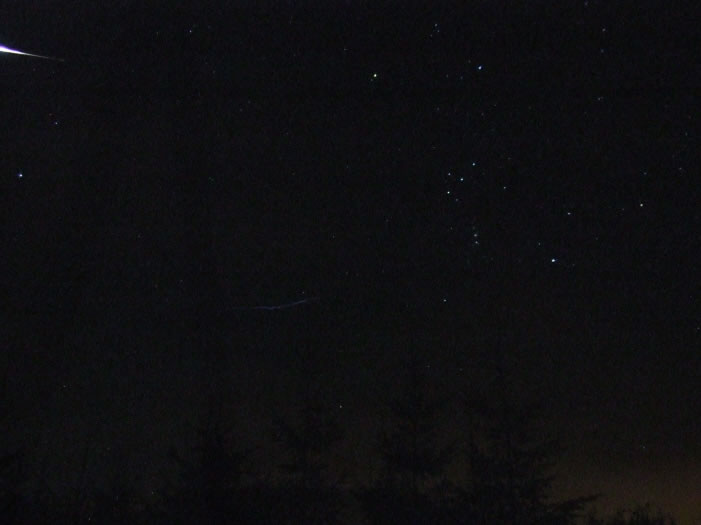 |
(Above) Two meteors in the one image! At the upper left of the frame is the leading edge of a mag - 10 to - 11 Leonid Fireball at 01.28 UT which has cast its shadow on a strip of lonely cloud/haze in northern Canis Major to the east of Orion (lower Centre) above the dark outline of the pine trees covering the eastern horizon. The fireball was moving from left to right. Can you spot the other meteor? Answer: it is the bright star above the three stars of 'Orion's Belt' only this meteor is not a streak but rather a point of light similar to a star as it struck the Earths atmosphere head on to the observer. This meteor was a sporadic and did not belong to any of the active shower sources. Image credit: Martin McKenna
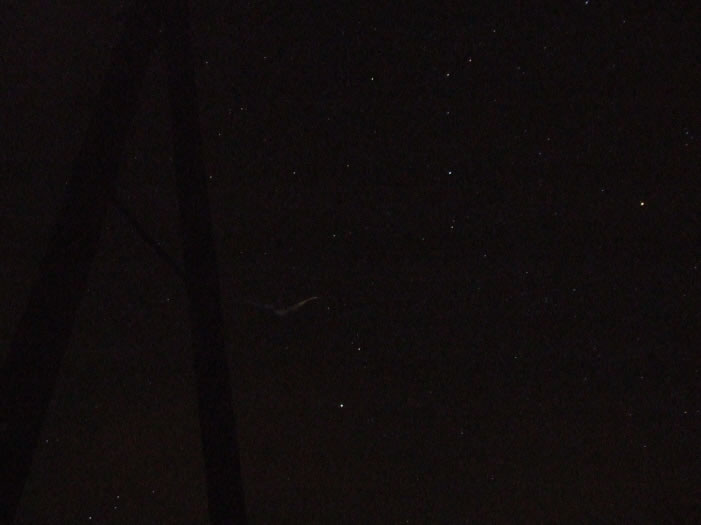 |
(Above) A twisted smoke train remains after the fireball burns up 30 seconds after the first image located NE of the bright star Procyon. Its slight chevron shape is blue on its eastern flank and orange to the west. Gemini is at the top with Beteleguese at upper right. The dark obstruction is a telegraph pole. Image credit: Martin McKenna
 |
(Above) The same smoke train imaged 19 seconds later and already showing a more curly physical profile. If you look carefully the middle section is split into two filaments of material with dark sky in the background. A dense knot of material has now formed on its western side. Image Credit: Martin McKenna
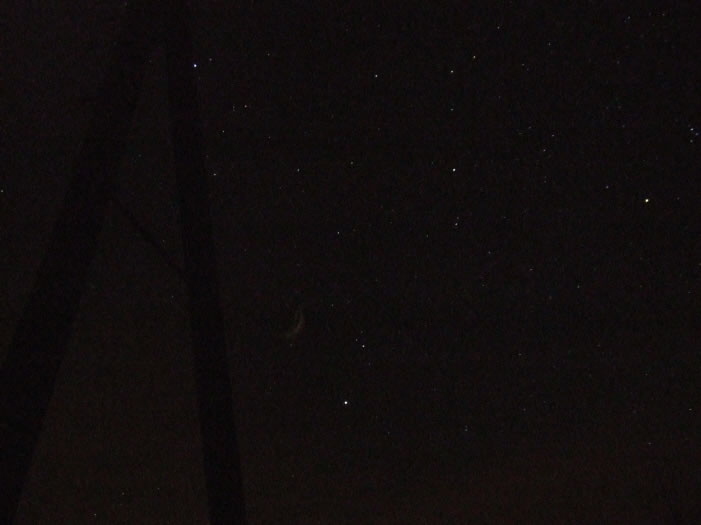 |
(Above) 66 seconds after the previous image the Leonid smoke train has again changed form into the shape of an orange waxing crescent moon. Note that the train has drifted ever so slightly eastward (left) due to a gentle high altitude breeze in the Earths atmosphere. This ion train was visible for over 7 minutes! Image credit: Martin McKenna
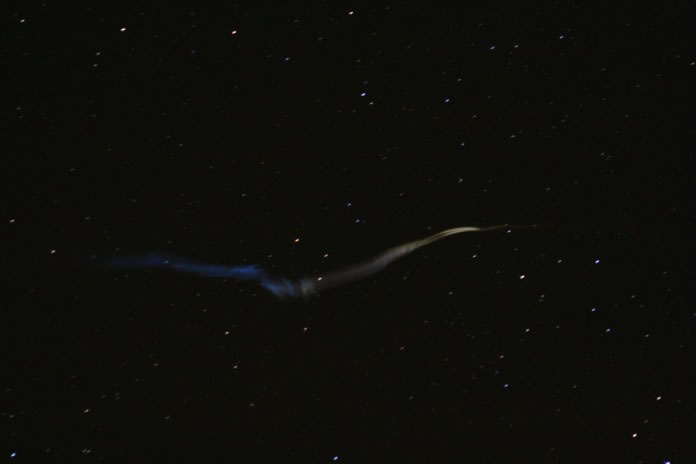 |
(Above) After the fireball, using honed instincts and quick reflexes Conor got in close to this fireball train using his Canon 350D with new 300mm zoom lens. This was the result! A stunning image of a highly structured smoke train with an apparent gap in the middle, linear and vertical divisions and multiple colours. Image credit: Conor McDonald.
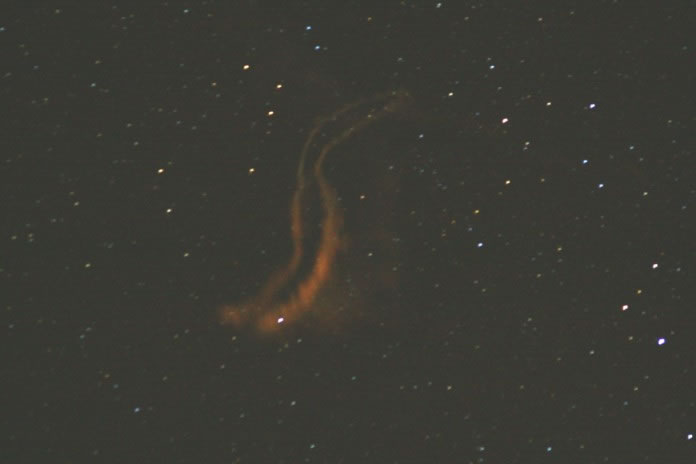 |
Two bright firey filaments of twisted fireball residue are captured on this zoomed in image presenting the appearance of a twisted snake. The foreground material is bright while the background material is fainter providing us with a very 3D like affect Image credit: Conor McDonald.
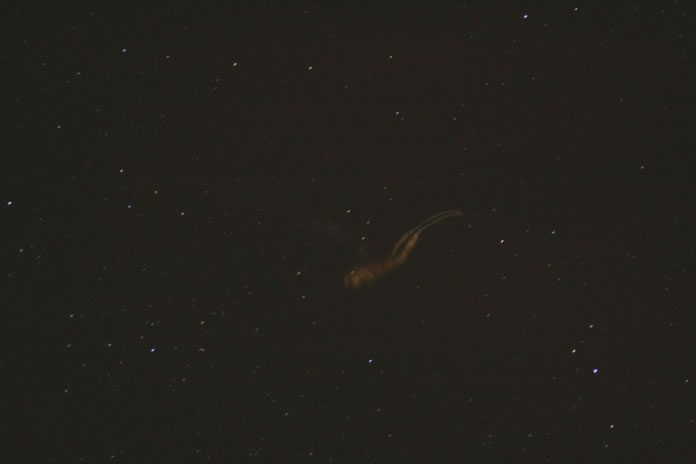 |
(Above) This is what happens when a lump of comet hits the Earth at 72km/sec. These are unforgettable sights. Image credit: Conor McDonald.
As you can see Conor's images are simply astounding. Fireball trains are a very rare sight but to actually see one of this brilliance and capture a high quality close image like these is another matter entirely. His quick reactions, good focus and exposure settings were a result of his constant practise and relentless familiarization with his equipment - a standard which could only be accomplished by a dedicated passionate astrophotographer who had put in the hours by the bucket full to get a result like this. Congratulations Conor! His three images document the changing profile of a train which consists of very complex structure and colour variation and I am sure some very real science can be obtained as a result. What a fabulous reward after 30 mins of observing.
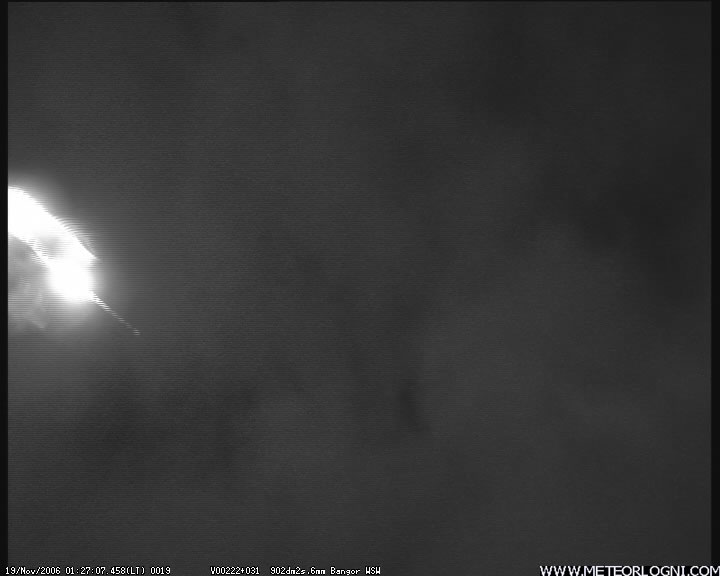 |
View Robert's fireball video footage here & mpeg encoded video here. The same fireball caught by the meteor tracking station run by Robert Cobain of N. Ireland. This is a single B&W frame from his video capture. The fireball can easily be seen through light cloud.
So how bright was this fireball? We made a few rough estimates at the time however even these did not touch on just how bright it really was. Estimating a fast moving object which is brighter than anything else in the sky is a difficult process as you only have a few seconds to process the visual information you just witnessed however in our case we had back up. Amateur astronomer Robert Cobain from N. Ireland runs a meteor patrol camera every night from his own home, a set up which in conjunction with the Armagh Observatory meteor tracking station can be used to triangulate meteor height and the possible location of any meteoritic fragments which might have made it to the ground from large objects. Robert caught this fireball through light cloud and estimated its magnitude at between - 10 and - 11, in other words almost as bright as a full moon!
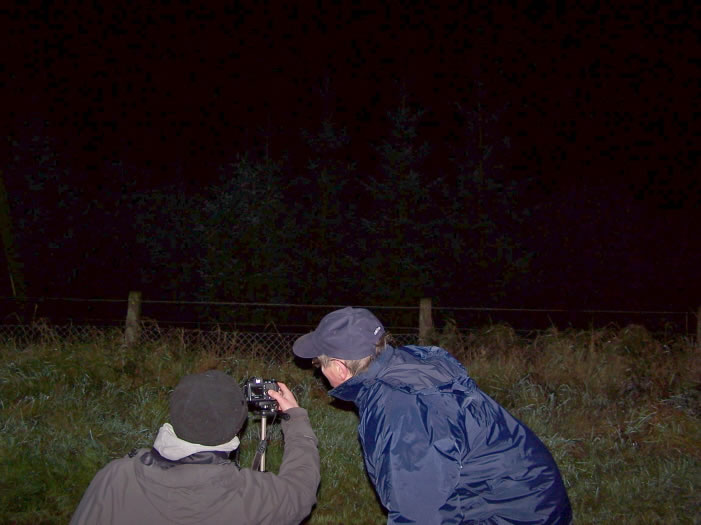 |
(Above) John and Martin preview the fireball capture on the camera's LCD screen. Image credit: Jonathan Bingham
The fireball was a good omen as very soon we began to see good Leonid activity which was quite surprising as the peak was over 3 hours away. Jonathan got to witness another rare event - a head on Leonid meteor which came straight from the radiant directly towards the observer. When this happens no meteor trail or movement of any kind is witnessed but instead a star suddenly appears where non was before, brightens quickly, fades then is gone again. These are quite a special sight and Jonathan described it as a sudden 'supernova'.
Just before 02.00 we seen 8 Leonid meteors in 10 seconds!!! This was very impressive and a rate which I have never seen before in my life in such a short time frame. Conor seen a mag - 5.0 Taurid fireball followed not long after by a mag -5.0 Leonid Fireball at 03.25 UT. Time was going in fast and the meteor rate seemed to be improving all the time. Each time a meteor was seen I had to record it on my notepad using a red pen which was a quick and relaxed process however as the night went on and we entered the pre dawn hours I felt like my pen was spending more time outside my pocket than inside!
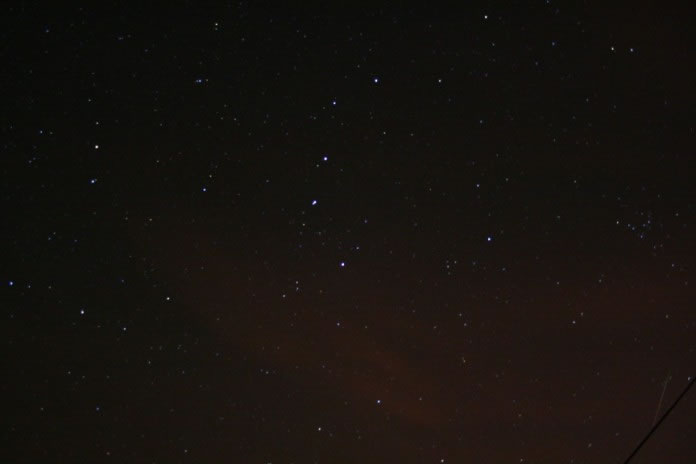 |
(Above) A faint Leonid meteor cuts through Coma Berenices (lower right) in the NE pre dawn sky. Ursa Major is to the left with Canes Venatici at centre. Image credit: Conor McDonald.
The frost was harsh and beginning to take its toll on the observers and equipment, wiping the cameras lens clean was a regular occurance and we even had to set the gear inside the car and turn the heat on to thaw the vunerable DSLR's out which worked with varying degrees of success. John's cable lock was damaged so in order to take an exposure he had to manually hold down the shutter button for long periods of time, any movement at all would have sent vibrations through the camera so John had to keep completely still without even talking which was a harsh task in a - 2*C frost. Afterwards John himself said that he felt he had rigor mortis! His persistance paid of when he caught a swift Leonid meteor pass near the handle of the plough, an area of sky within his patrol sector. Once John gets his film developed I will showcase his image here. - Nice catch John!
The last two hours before dawn are a great time to watch man made satellites emerge from the Earth's shadow and enter into the glare of the sun where they can be seen in a dark sky as slowly moving stars. We seen a number of fairly bright Iridium flares however the highlight was a faint grouping of three stars which slowly crept among the stars in a triangular configuration, this cluster is well known within the amateur astronomy community as a formation of spy satellites whose purpose is unknown.
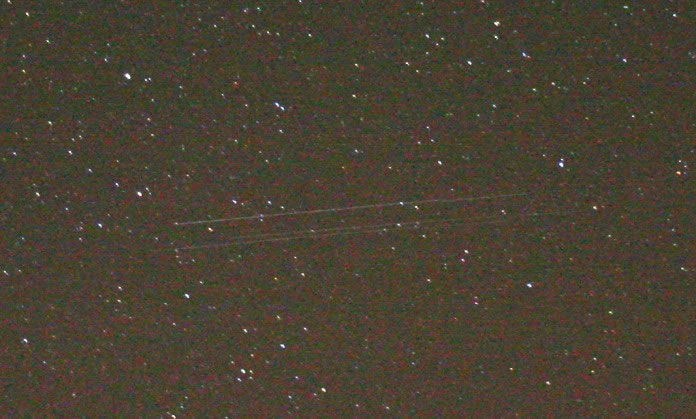 |
(Above) The three faint trails are the signature of a triangular spy satellite cluster moving from right to left across the field. You can see the trail fading with distance to the right. Image credit: Conor McDonald.
During our busy pre dawn meteor patrol this triangular cluster was spotted in Cepheus, and we watched with awe as it crept among the stars moving from NW to NE fading from mag + 4.5 to + 6.0. Conor was quick to react yet again and took the above image.
The night was drawing to a close, we were frozen and the cameras felt the cold worse than any of us. Leonids still could be seen arriving in bursts and from what we could tell the majority of them were now appearing in greater numbers in the northern sky sector behind our backs. So to accomodate this change in position we turned around to face north and set our cameras on a patrol through this area. We had decided to back our bags at 06.00 so I had only ten minutes left to catch something.
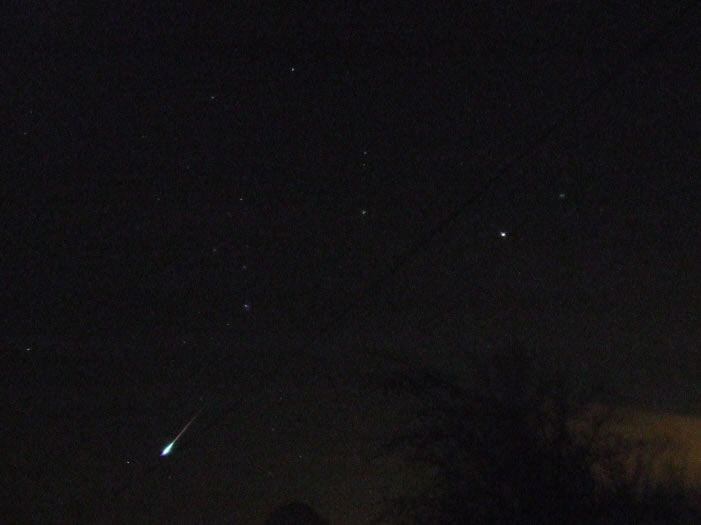 |
(Above) A mag - 6.0 Leonid Fireball passing through Hercules through low level murk. Image credit: Martin McKenna ISO800 15 sec exp at F/3.2
A fine film of frost covered the lens of my camera and I could no longer see stars on my LCD screen and to top it all off my red battery light was flasing rapidly so I decided to push every last second I could from my camera. I got rewarded! - after 600 patrol images spread over five hours a mag - 6.0 Leonid fireball dropped into the low NE sky at 05.56 UT as it passed through CrB and Hercules with a lovely tail. The fireball itself boasted orange, silver and green colours and vividly but briefly illuminated the frost coating the country road. It was a lovely object and our fourth fireball of the night! I let a roar of triumph out of me, I was delighted with my catch.
At 06.00 we drove home along the treacherous icy roads and everyone parted for the night. I stayed out until 06.30 and bagged a few more to our tally however haze, clouds and morning twilight moved in to end the night. The table below shows the observed hourly rates from several different meteor radiants.
Hourly Watch (UT) |
Leonids |
Taurids |
Non Shower Meteors |
Total |
Fireballs |
01.00 - 02.00 |
7 |
7 |
3 |
17 |
1 |
02.00 - 03.00 |
33 |
7 |
2 |
42 |
0 |
03.00 - 04.00 |
34 |
3 |
3 |
40 |
2 |
04.00 - 05.00 |
52 |
8 |
3 |
63 |
0 |
05.00 - 06.00 |
59 |
2 |
2 |
63 |
1 |
06.00 - 06.30 |
3 |
- |
- |
3 |
0 |
Total Meteors Observed = 228
Total Leonids Observed = 188
Total Taurids Observed = 27
Total Non Shower Meteors Observed = 13
Total Fireballs Observed = 4 (3 Leonids & 1 Taurid)
Estimated Leonid Average ZHR Based On Our Visual Observations = Late 50's - early 60's.
As you can see from the table above we seen a very impressive tally of meteors during our five hour watch. In total we seen 228 meteors of which 188 where Leonids. By the time we left it became apparent that based on our own visual meteor count the Asher - Mc Naught outburst had arrived much earlier than expected and lasted for a duration of four hours. Noticeable enhanced Leonid rates were observed from 02.00 - 06.00 with a two hour peak taking place between 04.00 - 06.00 with nearly 60 Leonids per hour which nicely agrees with the predicted outburst time. Considering that the Leonid radiant was only half way up in the sky before dawn then the true ZHR must have been much higher indeed. The 2006 Leonid outburst was confirmed! It is still at an early stage yet to jump to conclusions and to find out the full story observations from around the world will have to be gathered to show us the complete story.
This was a truely memorable night, everything went perfectly from the first second we arrived at our location. The environment, sky, weather and meteors all exceeded our expectations. There was never a dull moment in the night as we got a sudden burst of Leonid meteor activity followed by a calm interval which was filled with Taurid and sporadic meteors until the next burst of Leonids arrived. We noticed that 90% of the Leonids seen left behind bright persistant ionization trains lasting several seconds after the meteors passage. At times 2 Leonids appeared at the same time moving close by and parallel to one another leaving twin orange ion trains among the stars like skis. We even seen meteors crisscrossing at a 90 degree angle forming a cross in the sky!
The sudden bursts were composed of mainly faint Leonids however larger fragments produced the four fireballs observed, a selection of borderline fireballs and a high number in the mag 0 to 1 range. There was never a dull moment and we all felt very impressed by the show. I am still buzzing from the Leonids as I write these words a full seven days after the meteor shower took place and I think I speak for all of us when I say that the night was a resounding success in every way. This was an observing session that will never be forgotten and one which will be talked about in years to come. Future Leonid meteor watches in years to come will be compared to that incredible night in 2006 when we watched 228 comet fragments burn up in the sky over Maghera to spectacular effect. On a personal level this was the best Leonid meteor shower I have ever witnessed and I can think of no better way to have experienced it than the way I did with Conor, John and Jonathan. Thanks guys for comming down and making it a memorable night!
So what's next? My favourite meteor shower of all - 'The Geminids' takes place in mid December. See you then
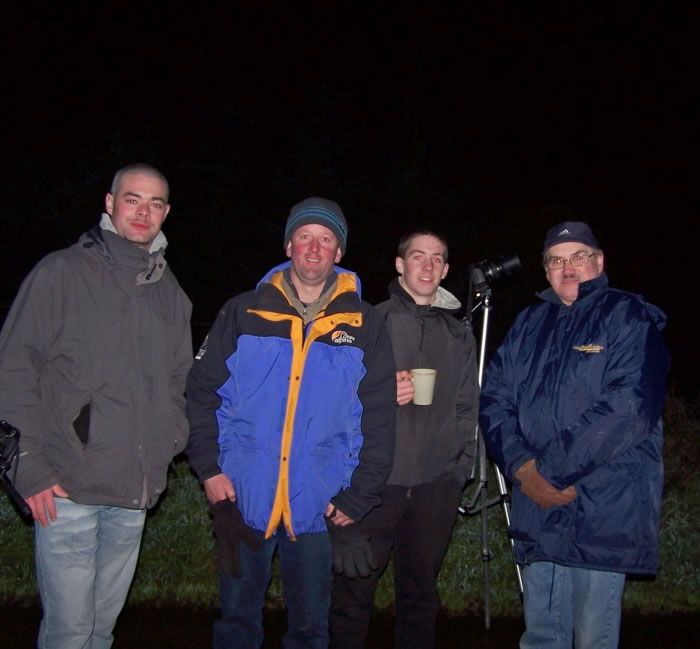 |
Left to right: Martin McKenna, Jonathan Bingham, Conor McDonald and John McConnell. Image credit: Jonathan Bingham.
Number of nights observing = 2
Number of hours observing = 13 hours
Total Fireballs Observed = 4 (Brightest: Mag - 10)
Total Meteors Observed = 250
Total Taurids Observed = 36
Total Geminids Observed = 3
Total Non Shower Meteors Observed = 19
Hours Of Sleep = 0.5!
Armagh Observatory 2006 Leonid Meteor Reports
2006 Spaceweather.com Leonid Meteor Gallery.
Radio Observations of 2006 Leonids
2006 Leonid Video Footage From Spain (Delphinus Meteor Observation Team)
Armagh Observatory Leonid Meteor Page
Armagh Observatory Leonid Meteor Dust Trail Page by Dr. David Asher
Leonid Meteors A Final Fling? (Armagh Observatory)
Dr. David Asher's Predictions for 2006
Forecast For 2006 From The IMCCE (Jeremie Vaubaillon)
Forecast For 2006 From Mikhail Maslov
Forecast For 2006 From Mikiya Sato
2006 Leonid Viewers Guide From Space.com
Viewing The 2006 Leonid Meteor Shower (AMS)
2006 Leonid Meteor Shower Article (EAAS)
Leonid Meteor Predictions For 2006 By Gary W. Kronk (C&MS)